Upon being wakened by herself, I was told that my father, both my brothers and my son were all snoozing this afternoon at various locations throughout the clan’s compound catching up from the rigours of train travel and watching fitba on the TV over mugs of tea. Were every afternoon so well spent. Once my auntie, over from the homeland, rose from a nap at the cottage and pronounced upon joining the rest that, if the Olympics allowed for it, she could sleep for Scotland. Know your strengths, I say.
Dubya the Canadian
I read this morning about what George W. Bush said about lawsuits and the need to cut back on awards being ordered in personal injury cases:
“The costs of frivolous lawsuits in some cases make it prohibitively expensive for a small business to stay in business or for a doctor to practice medicine, in which case it means the health care costs of a job provider or job creator is escalating,” Bush said. Bush spoke at a two-day White House economic conference, reiterating his oft-stated plea for Congress to impose caps on legal awards. “Justice ought to be fair,” the president said. “Those who have been hurt ought to have their day in court. But a judicial system run amok is one that makes it really hard for small businesses to stay in business.”
What a nut, I thought as I always do as a knee-jerk, me being a mere pawn caught between the propagandist intercessions of broadcast news and talk radio. But then I realized on this point he is just being a good Canadian. The majority of the Supreme Court of Canada in the case Ratych v. Bloomer, [1990] 1 S.C.R. 940 found the following:
It is a fundamental principle of tort law that an injured person should be compensated for the full amount of his loss, but no more. This is implicit in the principles governing the recovery of damages for personal injury set forth by this Court in the trilogy of Andrews v. Grand & Toy Alberta Ltd., [1978] 2 S.C.R. 229, Thornton v. Prince George School Board, [1978] 2 S.C.R. 267, and Arnold v. Teno, [1978] 2 S.C.R. 287. In the trilogy this Court affirmed that the purpose of awarding damages in tort is to put the injured person in the same position as he or she would have been in had the tort not been committed, in so far as money can do so. The plaintiff is to be given damages for the full measure of his loss as best that can be calculated. But he is not entitled to turn an injury into a windfall. In each case the task of the Court is to determine as nearly as possible the plaintiff’s actual loss. With respect to non-pecuniary damages, the task is necessarily imprecise, and resort must often be had to conventional figures. But where pecuniary damages are at issue, it is the actual pecuniary loss sustained by the plaintiff which governs the amount of the award. The functional rational for the award of damages adopted in the trilogy of Andrews, Thornton and Teno underlines the necessity of using the plaintiff’s actual loss as the basis of his or her damages. The award is justified, not because it is appropriate to punish the defendant or enrich the plaintiff, but because it will serve the purpose or function of restoring the plaintiff as nearly as possible to his pre-accident state or alternatively, where this cannot be done, providing substitutes for what he has lost.
All the US wants is something we have which is not water or mile after mile of untouched woods. Prudence and common sense.
Early PIPEDA Appeal Ruling
For those of us trying to keep up with the meaning of the newish Personal Information and Protection and Electronic Documents Act, the ruling of the Federal Court of Appeal in Englander v. Telus is interesting for its ennunciation alone. One interesting point to note is a statement in relation to the somewhat daft but perhaps brilliant use of lay language in the key schedule to the statute:
[45] The Court is sometimes left with little, if any guidance at all. Clause 4.3, for example, requires knowledge and consent “except where appropriate.” Clause 4.3.4 sets up a standard of “sensitivity of the information,” only to add that “any information can be sensitive, depending on the context.” Clause 4.3.5 then goes on to say that “[i]n obtaining consent, the reasonable expectations of the individual are also relevant.”
[46] All of this to say that, even though Part 1 and Schedule 1 of the Act purport to protect the right of privacy, they also purport to facilitate the collection, use and disclosure of personal information by the private sector. In interpreting this legislation, the Court must strike a balance between two competing interests. Furthermore, because of its non-legal drafting, Schedule 1 does not lend itself to typical rigorous construction, In these circumstances, flexibility, common sense and pragmatism will best guide the Court.
This is the first higher court ruling which I have seen on the statute and marks the beginning of the interpretation of its principles which will flesh out the meaning of privacy in the private sector in common law Canada. Quebec, as we all know, operates under the civil code system, has had its own statute for a decade and protects privacy in the Quebec Charter of Rights and Freedoms. A more private place.
Joe Howe 200th
Interesting to note that next week will see the 200th anniversary of the birth of the greatest Nova Scotian and a great if reluctant Canadian, Joeseph Howe. Perhaps in commemoration, I will dig out that book of his early writings I have and repeat all the bad things he had to say about Truro 175 years ago.
My Next Computer
Apparently it will make me use my Red Sox’s cap to move the mouse and that mouse will appear on my forearms. Futurists bust me up. Keep in mind the computer you are looking at is structured 90% like one in a basement in California from 1973 – but for that speed thing.
Belgium: Thinking About Four Sorts Of Brown
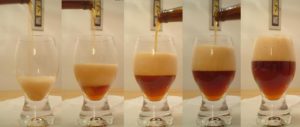
Continuing in the style of Four Belgian Blondes and Four Wittes, I am going to try to work through the Belgians I have squirrelled away over the last few months style by style. I also want to avoid one problem that arises doing a side-by-side, especially when you are looking at triples and strong ales. Four of those at 8 to 11%, especially when one or two only come in a quart, can frankly blow the top off yer heed. So, to ensure some benefit of the colour and head comparison, while at the same time avoiding a public display of the ever famous liquid lobotomy, I have decided upon a handy-dandy chart format for these posts. As I open each brew within the set, I will add it to the table with a photo of its label and one of the pour along with some notes. Click on the photos for a bigger view.
The trouble with this first set, however, is that they are not a style all. They are just a grab bag of styles all of which fall under the word “brown” more or less. The Petrus is a tangy Oud Bruin, while the Leffe Brown is something more familiar, a rich brown. The Kasteel is more of a barleywine while Rodenbach Grand Cru is a sour beer gone mad – the best malt vinegar you will ever find. All, however, are forms of browns from Belgium.
| Belgian Browns | Bottle and Pour | Notes |
|---|---|---|
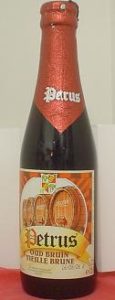
Petrus Oud BruinFlemish Brown |
translucent mahogany |
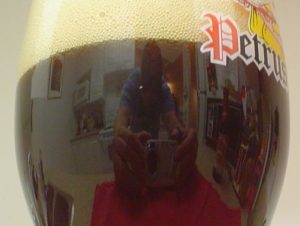
Lambic-like, sour cherry aroma, refreshing but also, at its core woodsy. Tart orange and spicy but in a good Christmas cake way. The body is not heavy. Slight carbonation – very light for a Belgian. 5.5% in a 250 ml bottle. BAs speak. |

Kasteel IngelmunsterQuadruple or Barleywine
|
Demarrara |
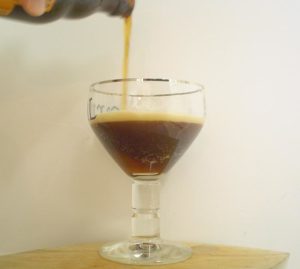
This is a dandy big beer – brown sugar plumy or red grape malty goodness at 11%. Without a trace of orange peel or spice so no hint of a dubble. No sour at all so nothing oud about it. This is surprisingly fresh for its bulk…like me. Rummy. Very subdued hops, only enough to keep the sweetness from being cloying. Here is the brewery’s take on it. A juicy swallow ending in a hot port finish. 330 ml bottle. Advocates comment. |
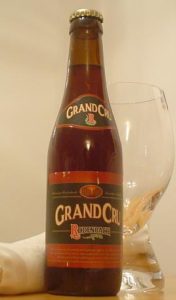
Rodenbach |
cherry wood patina |

I said that this was the best malt vinegar you will ever taste and I am not kidding. This is pure soured, oak aged Belgian brew. Michael Jackson is kinder speaking of a vanilla-like oakiness, passion-fruit flavours, a clean sharp acidity like sour cream. That is all there but you have to appreciate that the acidity is that of a sub-puckeringly sharp wine. Vineous does not cover how sharp. Tart but only in the sense of King Tart of the Tartonians. Within the tart the is some reflection of spice and certainly a gooseberry-rhubarb custard trifle would go well with this. That acid lingers the palate with the yeast with some deference to richness. It is nice. Try it but prepare to wish for a nice light double IPA as a cleansing light chaser. 6% in a 330 ml bottle.Beertonians blown away. |
|
Leffe Brown Belgian Dark Ale
|
Chestnut |
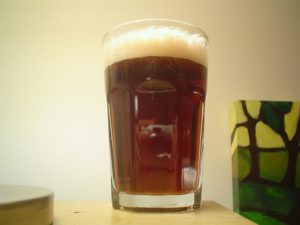
Hard label this one. It has some rich round brown like the Kesteel and also some tang like the Flemish Browns. Another calls it an almost double and another a dark ale. But labels have a limit. A lively head which leaves a rich foam ring. Medium to strong body. Cream and chocolate with a strong hop edge cutting the sweet. 6.5% in a 330 ml. Great on tap.Beersters consider. |
Forgotten New York
If I haven’t told you who pass by here often enough, please check out Forgotten New York – this week’s post on some of Staten Island’s oldest buildings is a great example of how the web can actually be an amateur interest archive of sorts.
The Cob
 This is the TV show I not only want to be in – but host. It may have an alternate title like “What Not To Be”. It is all about the ideal of the average male…or maybe an average ideal about a male.
This is the TV show I not only want to be in – but host. It may have an alternate title like “What Not To Be”. It is all about the ideal of the average male…or maybe an average ideal about a male.
Here is the premise. Me and portland get a bunch of guys to take the bait and sign up for a reality show. In that show, we promise, somewhat like “The Swan” to recreate you, but as a real guy. Like “What Not To Wear” we promise to renew your ability to interact with humans as a better you – but, unlike these shows, we teach the poor saps who are competing for our good opinion to actually be a good person, not just look like an attractive person. We will not make you richer, get you a better carrer or make your home a mansion. We teach you not to be a jerk or humilate you trying.
In one episode, we take apart the jerk who treats pals’ sisters like crap and leave him a whimpering ball of jelly at around 23 minutes past the hour. We break in on a date gone wrong with the girl of his dreams, show how a slob can treat a lady right (portland’s talent shining here) and leave him in our tracks begging to learn the secrets of being decent. But 57 after the hour, we do. In another show, we start by taunting pro-bowlers from the stands about spending more time with their families instead of on the lanes of mid-sized Mid-West towns. They learn to get real if dullish jobs with reasonable long-term prospects and get a hobby involving something actually useful like homebrewing. I can do that. In the grand finale, we teach a group of the quiet and shy to rock-out, live on gin and condiments for a week and finish a big night out having eggs on toast at dawn in a town where no one speaks your language or takes your currency. The winners of every episode compete for a big final prize at the end of the season, which we award arbitrarily to someone who shares the cash with us as a lesson that life is not based on merit.
It could happen.

